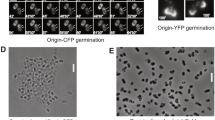Abstract
IT has recently been reported by Takeichi1 that the effect of ultra-violet light in inducing somatic segregation in heterozygous diploids of Aspergillus sojae is not altered by subsequent exposure of the irradiated conidia to visible light. As with other micro-organisms, it was found that the viability of the ultra-violet irradiated conidia was significantly increased by the visible light treatment, and it was therefore concluded that the effect of ultra-violet light in inactivating diploid conidia may be distinct from that which induces somatic segregation. This result is not the same as that found in a similar experiment with a heterozygous diploid of Ustilago maydis.
Similar content being viewed by others
References
Takeichi, C., J. Gen. App. Microbiol., 7, 89 (1961).
Holliday, R., Genet. Res., 2, 231 (1961).
Holliday, R., Genet. Res., 2, 204 (1961).
Landen, E. W., J. Cell Comp. Physiol., 14, 217 (1939).
Novick, A., and Szilard, L., Proc. U.S. Nat. Acad. Sci., 35, 591 (1949).
Kafer, E., Nature, 186, 619 (1960).
Author information
Authors and Affiliations
Rights and permissions
About this article
Cite this article
HOLLIDAY, R. Effect of Photoreactivation on Ultra-violet-induced Segregation of Heterozygous Diploids. Nature 193, 95–96 (1962). https://doi.org/10.1038/193095b0
Issue Date:
DOI: https://doi.org/10.1038/193095b0
- Springer Nature Limited
This article is cited by
-
Filamentous fungi exposed to spaceflight stresses including known levels of ultraviolet irradiations
Space Life Sciences (1973)
-
Relation between repair mechanisms and induced mitotic recombination after UV irradiation, in the yeast Schizosaccharomyces pombe
Molecular and General Genetics MGG (1972)





